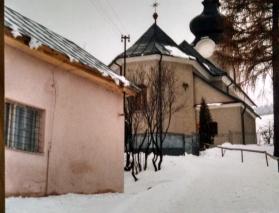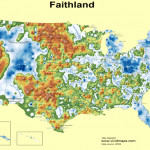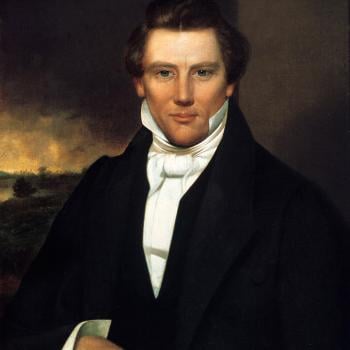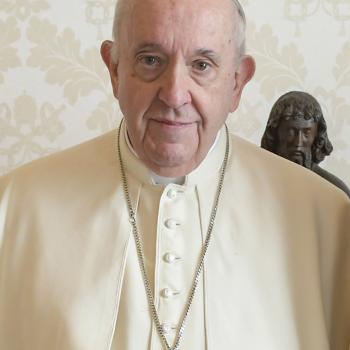 In the mid-1990s my husband and I, living in southern Germany for his fellowship year, traveled to the Slovakia hometown of my distant cousins. We didn’t plan the trip well, expecting to pass through Eastern Europe during a still-wintry Holy Week on way to Krakow. Rookie mistakes in the days before cell phones left us stranded in a train station, overnighting in musty post-communist hotel, and only reaching Litmanova by shoving our way onto an early morning bus with all the other people trying to get home for Easter.
In the mid-1990s my husband and I, living in southern Germany for his fellowship year, traveled to the Slovakia hometown of my distant cousins. We didn’t plan the trip well, expecting to pass through Eastern Europe during a still-wintry Holy Week on way to Krakow. Rookie mistakes in the days before cell phones left us stranded in a train station, overnighting in musty post-communist hotel, and only reaching Litmanova by shoving our way onto an early morning bus with all the other people trying to get home for Easter.
We were most ready, then, for a peaceful breakfast around the cloth-covered table in the kitchen of the house my cousin had built for his family. Eating a late share of their coffee, bread, and jam, we could hardly refuse the vodka offered alongside of it without offending our host. Although my parents’ families all emigrated from Slovakia, and I recognize a few words, I could hardly speak any. Nor could my cousin’s family speak English. So we were grateful for translation provided by a neighbor summoned from down the street, a young woman who had spent some months with her relatives in New Jersey. My cousin asked about my family, and about our year in Germany, and we asked what was going on with them.
It was in English fluent and Jersey-accented that we were told, between sips of breakfast vodka, that there had been apparitions in town. My husband and I continued to eat and drink while our hosts waited for our reaction. We did not react at first, perhaps mishearing or thinking something mistranslated. Diagnosing our blank looks, the neighbor explained. There had been apparitions. The Blessed Virgin Mary had appeared in Litmanova.
Probably many other responses would have been more appropriate than awkward silence. Language barriers and, at least on my part, a kind of combative Protestantism closed other options. The report that Mary had been visiting this village were perplexing. We—probably rudely—did not ask to visit the site. But I thought about it all day. We greeted more relatives with nods and smiles. We watched old women bake the same bread my mother and my Baba made every Easter. We joined them in church for a Good Friday service. While my extended family is Roman Catholic in the United States, these were Eastern-rite or Greek Catholics, whose liturgy follows patterns more similar to Eastern Orthodoxy. The priest faced the altar, men and women stood on different sides of the dark wooden building. I had wanted very much to participate in this part of preparing for the Paschal celebration with my cousins, to gin up a sense of cultural connection with the Old Country, but mostly felt estranged. Where to put those Marian apparitions? Wasn’t it just the thing one would expect from the halfway-to-modernity cast of the whole village, where the few cars shared dirt roads with crossing chickens? Or was it Romish error—a charge I would never have said but might have felt, that some body is making this up for credulous believers?
Here are the basics of the story that I did not then trouble to understand. In August 1990 two teen girls, Katka Ceselkova and Ivetka Korcakova, were on Mount Zvir playing games and picnicking when they heard a loud noise and saw a strange light. They hid in a hut. The Blessed Mother appeared to them in several places. She revealed herself as “Immaculate Purity.” The girls confirmed to each other what they had seen but were disbelieved at first. Local authorities later accepted their reports. The girls returned to the mountain over several years, and Mary appeared to them again and again. After silent visitations, Mary began giving them messages, bewailing people’s desire for material things and calling for repentance, love, and forgiveness. The girls kept a discipline of prayer and observed local miracles connected with the visitations. The site was consecrated and pilgrims began traveling there.
Our trip to Litmanova occurred shortly before the apparitions stopped. Mary last appeared to the girls in August 1995. Both young women continued to testify to the experience as they grew up and eventually married. In a documentary about the experience, Ivetka gives voice to the desolation she felt when when the visits stopped coming. It’s a stark version of what Walker Percy calls the problem of reentry: when the Virgin Mary has been appearing to you and then stops, how do you go out again on an ordinary weekday morning and feed the chickens?
I wish I could consign to oblivion my dismissal of Litmanova’s apparitions. My response should perhaps not be excused too quickly. On a personal level indulgence could be sought on grounds that this was a spiritually difficult period, one spent thrashing through (some good) questions, of Protestant type, about the Roman Catholicism in which I was raised. But not so fast. My response also reflected common, haughty ways spiritual experience of others can be summarily dismissed. As some historians have noticed, Marian apparitions were not scarce in eras we count as secular ages, and these spiritual events demanded reshuffling of some political and institutional priorities. Sometimes those who write about visions of Mary in Fatima, Lourdes, or the Bronx seek to take the events seriously while operating under the assumption that the things actually could not have happened. A couple common strategies help accomplish this: by neutralizing someone’s vision of the holy into anthropological curiosity, by psychologizing girls’ imagination of “Immaculate Purity,” or by reckoning the believers as primitive, even finding them charmingly so. You saw Mary; how interesting. Properly disciplined, such experiences can even seem precious to incredulous observers. As Robert Orsi argues in his study of real spiritual “presence,” “Romantic moderns have wanted the people whose lives do not conform to the normative modern to remain that way, so that they might continue to be enjoyed as exciting alternatives to modernity.”
My flinching at Litmanova’s apparitions came from what felt like heavy-starched Protestant principle and not impulses of the “normative modern.” Still, I’d try to brake that response more now. And listen to the tidings that bade penitence, love, and forgiveness.













